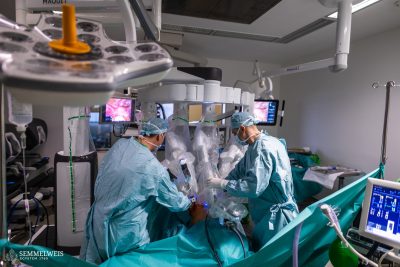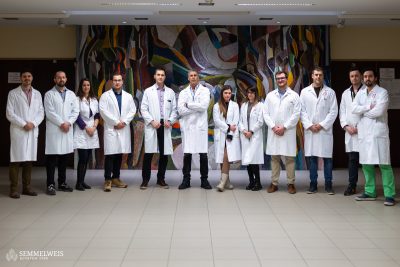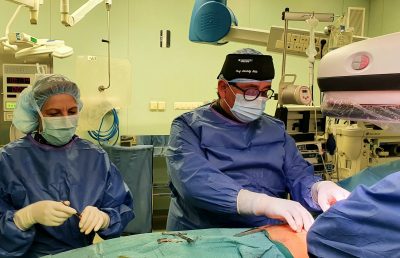The Neuropsychopharmacological and Neurochemical research team, which was established on July 1st by Dr. György Bagdy, focuses on improving the possibilities of treating depression. The research project’s title is: The Examination of the Role of Environmental and Inheritable Factors in the Emergence of Human Depression through Genomical and Picture Imaging Methods.
 ,,In practice this means that from our daily problems and from the stress that affects us, through the visualized process of our brains, we get all the way to the level of molecules so that then we may build a satisfactory model for certain groups of people and situations that may be used in clinical practice and therapy.“ – explained Professor György Bagdy, director of the Department of Parmacodynamics.
,,In practice this means that from our daily problems and from the stress that affects us, through the visualized process of our brains, we get all the way to the level of molecules so that then we may build a satisfactory model for certain groups of people and situations that may be used in clinical practice and therapy.“ – explained Professor György Bagdy, director of the Department of Parmacodynamics.
The choice of the topic is justified by the frequency of the occurrence of depression which – according to the predictions of WHO – will be the most burdening illness regarding the quality of life in middle and high income economies by 2030. Despite the fact that we possess effective antidepressants, only 50% of the patients show improvement after the first treatment, and an estimated of 1/3 of them don’t get better even after the fourth treatment. The treatment may even increase distress in a small group of patients. The topic’s saddening actuality is emphasised by the fact that the economic crisis – as an environmental factor – has further aggravated the situation. Thus, for example, the decades-long tendency of decreasing number of suicides in Europe has halted. “It is our aim to be able to determine who suffers from serious mood swings due to environmental factors and what kind of alternative and medicinal treatment possibilities we may offer to that person.”
Professor Bagdy and his team are not new to this subject: they have already dealt with this topic as one of the most successful members of a big international syndicate supported by the EU between 2004 and 2009. Apart from genotypically extendable samples, they now possess a databank of several thousand people that contains personality traits, environmental factors and response strategies used in stressful situations; all thanks to their project. As a result, numerous scientific articles were born that encouraged serious debate. Thus, Dr. György Bagdy and his team were the first to write about the connection between serotonergic system and the endocannabinoid CB1 receptor. Also, they have identified many of the unknown effects and side-effects of numerous antidepressants that are currently in use.
“On one hand, one of our main goals is to predict the effects of the currently used antidepressants, on the other hand we wish to identify new therapeutic targets” – answered Dr. György Bagdy when we asked him what they would like to achieve at the end of the 5 year period supported by the Hungarian Academy of Sciences. As he explained, the precise knowledge of the symptoms may help in planning the treatment in some cases, but we still haven’t identified the right biological markers which would predict the effects and side-effects of antidepressants even though these would provide guidance in creating personalised treatment. The professor also stressed that along with the medications used today to treat depression we would also need to develop medications with completely different underlying system of effects. This process has to be preceded by and based on the identification of neurobiological pathways and their protein components which all play a part in the emergence of human depression.
In accordance with the application guidelines, the team consists of young scientists: doctors, pharmacists, biologists, psychologists and bioinformaticians. The majority of them are researchers, who have obtained qualification in a laboratory – or they will in the near future – and whose skills and commitment toward science were observed by the professor beforehand.
Dr. György Bagdy has mentioned by name – among others – Dr. Gabriella Juhász, who finished at Szentágothai János Doctoral School of Neurosciences following which she worked with Dr. Bagdy at a European consortium already in the employment of the partner in Manchester. The neurologist – who is one of the leading teachers of the Department of Pharmacodynamics – has presented results in the fields of genetics and pharmaco- and functional MRI. Dr. Xénia Gonda is also a member of the team who obtained the scientific qualification in 2009 on top of her two other diplomas and by now she has become an internationally renowned expert of the personality traits and temperaments that play a part in the development of depression. Dr. Judit Lazáry – also part of the team – was awarded the Junior Príma award in 2012. The prospective psychiatrist presented the ‘mood-creating genes’ to the audience at the Kutatói Szalon event (Researchers’ Salon) in April.
The Hungarian Academy of Sciences stated in May that it only supports 15 research groups in 7 universities throughout the country. Semmelweis University won two applications: Dr. Veronika Ádám, director of the Department of Medical Biochemistry and Dr. György Bagdy, director of the Department of Pharmacodynamics received support from the Academy to create research groups.
Pálma Dobozi
Translated by: Bonifác Makkai



